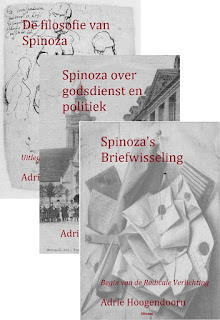John Toland (1670–1722) "A Confutation of Spinosa" in 'Letters to Serena'
John Toland "one of the most significant Anglophone intellectuals of the early 18th century," (aldus de heruitgever van onderstaand boek)muntte de term 'pantheism' om er Spinoza's filosofie mee te typeren, hetgeen in mijn ogen een niet erg gelukkige zet was. Daarover schreef ik dit blog in de begintijd van mijn Spinoza-studie dat ik nog steeds leesbaar acht.Van deze Toland verscheen in 1704 'Letters to Serena', een bundel van vijf lange brieven, zeg maar essays.
Letter IV "To a Gentleman in Holland showing Spinosa's System of Philosophy to be without any Principle or Foundation" was opgezet als verwerping van Spinoza: "A Confutation of Spinosa." Deze 1704-uitgave is bij books.google in te zien.
 Wim Klever die mij op de hoogte bracht van een heruitgave van dit boek, had het daarbij over "Toland's doortrapte misleidingskunst." Hij zal dus ook hem wel weer als een Iers-Engelse crypto-spinozist beschouwen. [Deze cynische opmerking haal ik bij nader inzien door, maar laat ik staan om de reactie te doen begrijpen]
Wim Klever die mij op de hoogte bracht van een heruitgave van dit boek, had het daarbij over "Toland's doortrapte misleidingskunst." Hij zal dus ook hem wel weer als een Iers-Engelse crypto-spinozist beschouwen. [Deze cynische opmerking haal ik bij nader inzien door, maar laat ik staan om de reactie te doen begrijpen]
Ian Leask (Ed.), John Toland's 'Letters to Serena'. Four Courts Press, August 2013
Over Toland en o.a. over deze 4e brief uit de 'Letters to Serena' schreef
Rienk Vermij, "Matter and Motion: Toland and Spinoza." In: Wiep Van Bunge & W. N. A. Klever (Red.) Disguised and Overt Spinozism Around 1700: Papers Presented at the International Colloquium, Held at Rotterdam, 5-8 October, 1994, Brill, 1996 [books.google]
Het Spinoza Research Network plaatste de volgende informatie bij het bericht over het verschijnen van dit boek die adequater lijkt dan mijn wat misprijzende commentaar hierboven op Klever's typering. Er blijkt een positieve waardering uit:
"John Toland (1670-1722), one of the most important thinkers of the ‘radical Enlightenment’, was part of the vanguard that helped to disseminate and develop Spinozistic ideas across Europe. Probably Toland’s most substantial philosophical work, the Letters to Serena (1704) carries out two separate tasks, united by a common strategy of ‘ungodding’ the world. In the first three Letters, Toland provides a genealogical examination – strongly influenced by Spinoza’s TTP – of superstition, prejudice and notions of an ‘immortal soul’; the supernatural is shown to be mere human invention. In the final two (more metaphysical) Letters, he first critiques Spinoza’s treatment of motion as a fait accompli: the Ethics rules out a transcendent or transitive cause of motion, and yet provides no alternative explanation. But to ‘solve’ the problem, Toland then draws on Leibniz’s insistence that force is an essential constituent of any substance – although, typically, he rips this Leibnizian principle from its original, theological setting. The result is that ‘motive force’ is used to bolster the sheer autonomy of the material world, and Spinozistic immanence thereby deepened and ‘improved’." [van hier]


Reacties
Misschien was het leerzaam voor je geweest, Stan, om eens na te gaan WAT Toalnd in de 4e brief weerlegde en WAT hij in de 5e brief betoogde. Dan zou je de suggestie dat ik verwijtbaar over de schreef ging, niet zo gemakkelijk hebben gedaan. En had je er ook nog wat van opgestoken.
Wim Klever 12-09-2013 @ 22:08
Sorry, Wim,
Ik heb mij ook op de vingers laten tikken door het Spinoza Research Network, waarvan ik de typering van de betekenis van het boek aan het blog heb toegevoegd. Dat van 'verdiepen en verbeteren' van het Spinozisme had door jou geschreven kunnen worden.
Stan Verdult 13-09-2013 @ 09:25
Behalve dan de misvatting daarin dat Toland een ' principe' aan Leibniz te danken zou hebben.
Wim Klever 13-09-2013 @ 11:40